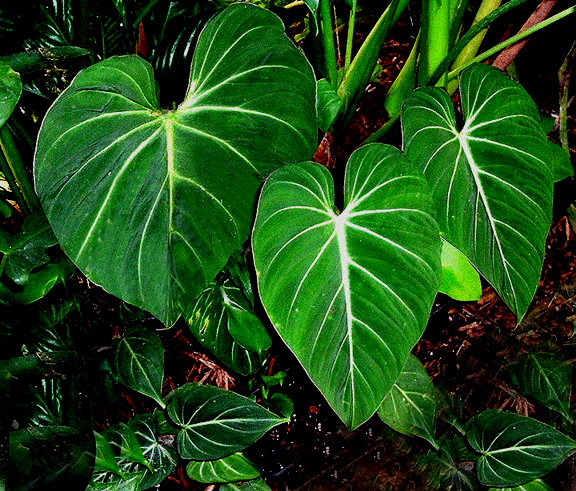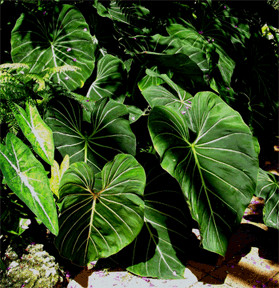![]()
Aroids and other genera in the Collection
Take the Tour Now?
Orchids
The
Exotic Rainforest
Plants in
the Exotic Rainforest Collection
Images on this website are copyright protected. Contact us before attempting to reuse.
In depth information on how to grow Philodendron species, Click this Link
Within our collection we have many species of Philodendron. If you are seeking other photos, click this link
Philodendron gloriosum André

Philodendron species, and especially hybrid forms, are known to be highly variable and not every leaf of every specimen will always appear the same. This link explains in greater detail the scientific principle of natural variation and morphogenesis. Click here.
The first time I saw Philodendron gloriosum the plant was for sale in Miami for $50! I wanted one, but not that bad. Now you can easily find Philodendron gloriosum for about $15 to $20 for a nice sized specimen. You can baby ones for under $5 if you are willing to wait the year or more to see it grow a 20cm (8 inch) leaf! That's due to tissue culture, or more simply: cloning. There is a very reputable company in central Florida that commercially "clones" plants for nurseries thus making some of nature's most beautiful and "rare" plants affordable. However, there is a drawback. The majority of tissue cultured specimens do not attain the large size blades found in the wild. It is speculated the process of the culturing process stunts the growth and prevents the plants from ever gaining the enormous sizes seen in the wild.
 The leaves of Philodendron gloriosum are reported to reach a size of
90cm (36 inches) in
it's native growing areas. The specimens to the right and below were
photographed at Fairchild Tropical Botanic Garden in Miami, FL inside
the lowland rain forest and the indoor rare plant conservatory.
These leaves easily measure 69cm (two feet).
The leaves of Philodendron gloriosum are reported to reach a size of
90cm (36 inches) in
it's native growing areas. The specimens to the right and below were
photographed at Fairchild Tropical Botanic Garden in Miami, FL inside
the lowland rain forest and the indoor rare plant conservatory.
These leaves easily measure 69cm (two feet).
Most people believe the plant is found only in Columbia. However, if you look the species up on TROPICOS (a service of the Missouri Botanical Garden in St. Louis) via their GOOGLE EARTH, you'll find the species is found in southern Mexico, all of Central America, Colombia, Venezuela, Ecuador, Peru and portions of western Brazil. The largest we have grown to date is close to 38cm (15 inches). The plant has a velutinous (velvet) appearance and feel and as the leaves reach maturity the white veins become more pronounced. One variation is sold with the claim it has "silver" veins. Personally, I see no difference.
Philodendron gloriosum is not a climber, it runs! The species prefers to grow in loose, well draining soil. Many growers prefer what is known as a "jungle mix" which is easily created by mixing a soil such as Miracle Grow Moisture Control Mix with peat, Perlite™, and and orchid potting media such as Schultz. I personally prefer the Schultz brand since it contains charcoal which helps to "sweeten" the soil. The mixture we prefer is 50%, 20%, 20%, 10%. Keep the soil damp, just not soaking wet.
 Many websites
suggest shade for Philodendron gloriosum. That is true if
grown in ideal conditions. At Fairchild Tropical Botanic Gardens
in Miami numerous large clumps are grown in deep shade with daily
watering and ideal temperature and humidity.
Others grow in extremely bright light. However, everywhere we have the plant where it can run towards bright
light it does! And the brighter the light the bigger the leaves
seem to grow. Philodendron gloriosum does not appear to
enjoy direct sunlight, but
it doesn't seem to crave deep shade either. Too deep shade in our
atrium and it
simply vanishes. P. gloriosum certainly does not appreciate
temperatures below 55 degrees F (12.75 C).
Many websites
suggest shade for Philodendron gloriosum. That is true if
grown in ideal conditions. At Fairchild Tropical Botanic Gardens
in Miami numerous large clumps are grown in deep shade with daily
watering and ideal temperature and humidity.
Others grow in extremely bright light. However, everywhere we have the plant where it can run towards bright
light it does! And the brighter the light the bigger the leaves
seem to grow. Philodendron gloriosum does not appear to
enjoy direct sunlight, but
it doesn't seem to crave deep shade either. Too deep shade in our
atrium and it
simply vanishes. P. gloriosum certainly does not appreciate
temperatures below 55 degrees F (12.75 C).
True to the name, Philodendron gloriosum is a "glorious" plant and one I can't wait to reach anything close to it's maximum size in the ExoticRainforest!
Want to learn more
about aroids?
Specimens may be available
from Natural Selections Exotics
or Brian's Botanicals
http://www.briansbotanicals.net/
Join the
International Aroid Society:
http://www.exoticrainforest.com/Join%20IAS.html
![]()
